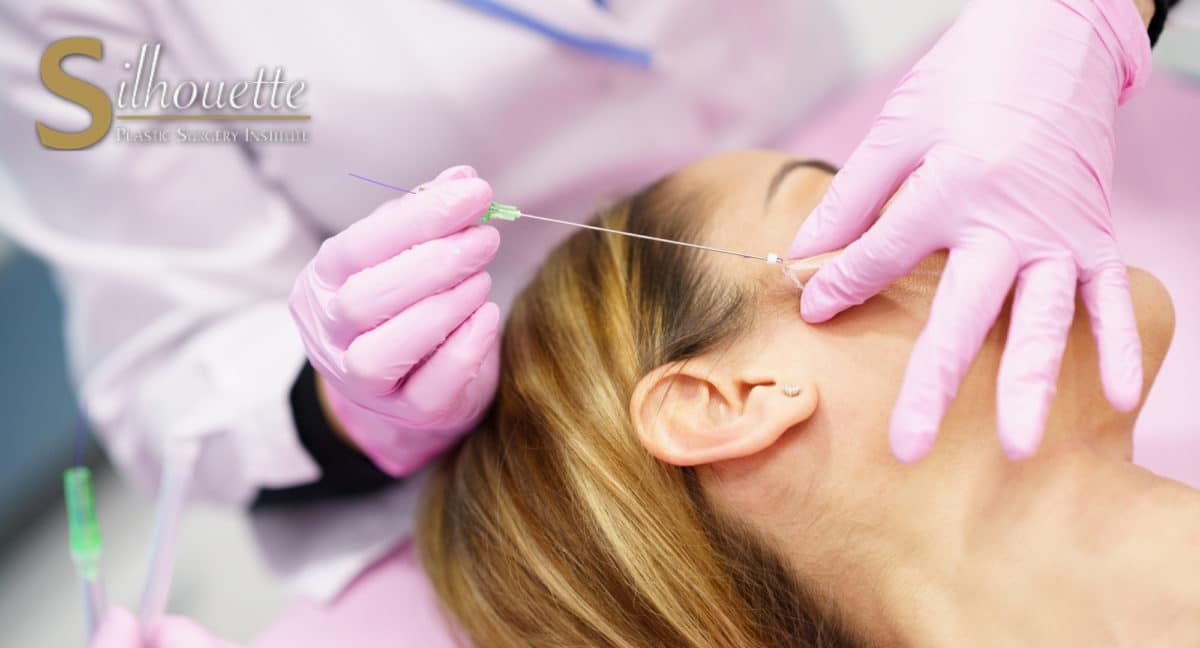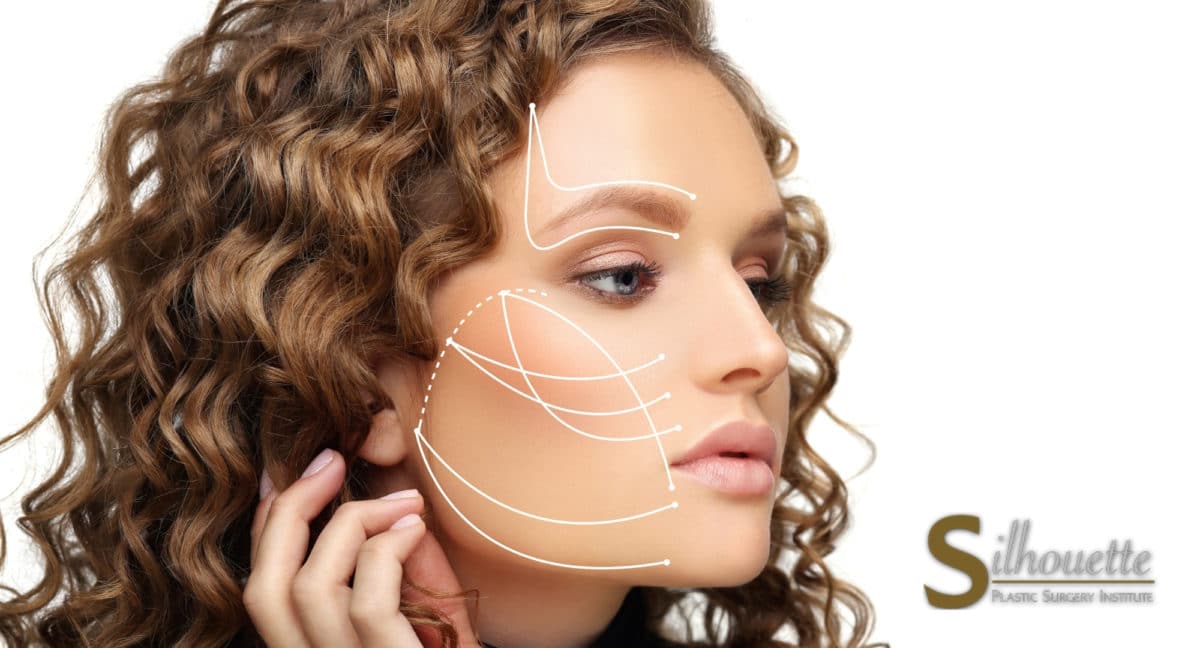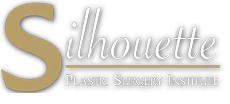Dr. Hootan Daneshmand
Thread Lift in Orange County and Bakersfield
Thread Lift Procedure
Maybe you’re aging quicker than you’d like and collagen supplements or creams aren’t slowing down the process. Sometimes, your skin may require a higher level of rejuvenation than the non-surgical treatments, like Botox Bakersfield, can provide.
If you’re not quite ready for an Orange County surgical facelift, then a thread lift procedure can be a great option for you.
Thread lifting is a minimally invasive procedure that uses specifically shaped sutures to lift the skin and help stimulate collagen production. Board-certified plastic surgeon Dr. Daneshmand has given thousands of patients a necessary confidence boost over the course of his career, and he can do the same for you too.
To schedule an appointment at our Orange County plastic surgery center, call 949-359-8397 today.

What is a Thread Lift?
A thread lift – also called a lunchtime lift – is basically the minimally invasive version of a surgical facelift or an Orange County vertical restore procedure. The barbed suture insertion procedure works by pulling your facial skin up and back with medical-grade threads, therefore giving patients a more youthful appearance. Thread lifts generally produce long-lasting results for 2 to 3 years.
How Does a Thread Lift Work?
Not only does a thread lift work by physically pulling up drooping cheeks and other facial features, but it also works by stimulating collagen production.
First, the skin is pulled tight by dissolvable threads attached to barbs under your skin. Then during the healing process, your body will begin to produce collagen around the treatment area. Your skin isn’t actually injured by the threads and barbs underneath your skin, but your body perceives injury anyway because the materials are basically foreign objects. Collagen is a crucial component for youthful and smooth skin texture.
Even though the threads underneath your skin will eventually dissolve, the collagen production from the treatment will keep you looking young and beautiful for several years. In fact, a 2017 study claims that 100 patients’ thread lift results lasted for about 3 years.
Thread Lift Treatment Areas
Thread lifts are ideal for areas of the body that have sagging skin, including the:
- Jawline
- Neck
- Under eyes
- Cheeks
- Breasts
- Brows
- Forehead

Who is a Good Candidate for a Thread Lift?
The best candidate for this minimally invasive procedure is someone between the ages of 35 and 55 whose skin laxity is beginning to suffer. At a certain point in the aging process, thread lifts can’t save deep wrinkles and major facial sagging. Patients who are suffering from sagging skin due to major weight loss or postpartum body changes may also be good candidates for thread lift procedures.
Additionally, it’s important for all thread lift patients to have generally good health to minimize the risks and complications.
Thread Lift vs. Facelift
The biggest difference between the two facial rejuvenation procedures is that one provides permanent results, while the other one doesn’t. Facelift surgery provides permanent dramatic results while the results from thread lifts tend to be temporary and generally natural. Additionally, traditional facelift surgery is much more expensive, has a much longer recovery time, and comes with far more risks and complications compared to a thread lift. If you’re considering a traditional facelift though, it’s a good idea to start with a low-risk, minimally invasive procedure like a thread lift. If you like the results, you may also like traditional facelift results as well.
Thread Lift Procedures
How to Prepare for a Thread Lift
Before any surgical procedure, it’s important to be honest with your doctor about your health conditions, your daily medications and supplements, and your diet. All of these factors can determine how well your body will tolerate the stress of a thread lift. Dr. Daneshmand will likely instruct you to avoid blood-thinning medications and NSAIDs a week before your treatment for the best outcome. Additionally, patients should avoid stress and alcohol consumption the night before their procedure.
What to Expect During a Thread Lift Procedure
As with any surgical procedure or treatment, it’s important for a patient to know exactly what they’re getting into before they actually go under the knife. The exact steps of a lunchtime lift may differ among plastic surgeons, but here’s a general idea of the process.
First, Dr. Daneshmand will ask his patient to relax in a reclining chair. Then, he’ll clean the treatment area and apply numbing medication or some other form of local anesthesia. Threads will then be inserted under the skin with the help of a tiny tube called a cannula. Inserting the threads is the most time-consuming part of the procedure. Once that’s done, Dr. Daneshmand will remove the cannula and send you home with aftercare instructions. The whole process generally takes about an hour.
What to Expect After a Thread Lift Procedure
You will likely experience minimal bruising, swelling, and redness in the affected area. This discomfort will gradually disappear over the course of a few days or weeks. Your results may be immediately visible, but remember that your appearance will improve even more as you heal. Most patients are able to resume their normal activities immediately following their thread lift procedure.
Dr. Daneshmand may recommend that you stop your usual skincare regimen and avoid rubbing your face for a few days while you recover. Additionally, he may advise against sleeping on the side of your face or body that underwent the thread lift. Instead, it’s best to sleep with your head propped up on a pillow. Lastly, Dr. Daneshmand may instruct you to avoid high-intensity workouts and saunas while you heal, especially if those two activities are part of your weekly routine.
Thread Lift Side Effects
Although a thread lift is a minimally invasive procedure, patients should still expect the following side effects:
- Pain or soreness where the threads were inserted
- Minor bleeding in the treated area
- Swelling and bruising
According to data from the International Society of Aesthetic Plastic Surgery (ISAPS), the average thread lift patient has a 15 to 20% chance of developing minor complications, including:
- Lumpy, bulging looking skin due to the threads moving
- Excess pain due to the threads pulling too tight under the skin
- Infection
- An allergic reaction caused by the thread material
- Skin dimpling where the surgeon inserted the threads
- Excess bleeding where the surgeon inserted the threads
If you experience any of the aforementioned complications, be sure to call your doctor. They can generally fix or reverse these complications. Additionally, if you experience severe infection symptoms such as fever, swelling that doesn’t improve, constant headaches, or oddly colored pus at the treatment site, you should seek immediate medical attention.
Thread Lift Cost
The best way to determine the cost of a thread lift treatment is to ask your specific clinic or plastic surgeon because costs certainly vary across the country. It’s safe to say that a thread lift is much cheaper than a traditional facelift, especially if the treatment area is small. For example, an Orange County breast lift using threads would probably be much more expensive than a thread lift treatment on one area of the face. In fact, a doctor included in a 2019 study stated that thread lifts cost approximately 40% of what surgical facelifts cost.
On a site called RealSelf, many plastic surgeons and patients across the U.S. connect and discuss the specifics of various procedures. According to this site, the average cost of thread lifts is $2,025 as of 2022.
Best Thread Lift Plastic Surgeon
At Silhouette Plastic Surgery Institute, our goal is to give you the most youthful, beautiful appearance that money can buy. One of many treatments that can certainly help you achieve your goal look is a thread lift. If you think this is the right procedure for you, give us a call at 949-359-8397 and we’ll put you on our schedule.
